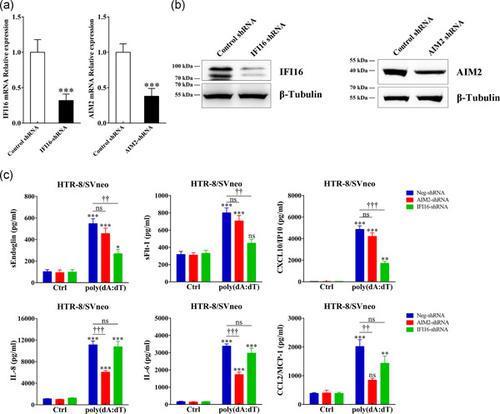当前位置:
X-MOL 学术
›
J. Cell. Physiol.
›
论文详情
Our official English website, www.x-mol.net, welcomes your
feedback! (Note: you will need to create a separate account there.)
Elevated cell-free fetal DNA contributes to placental inflammation and antiangiogenesis via AIM2 and IFI16 during pre-eclampsia.
Journal of Cellular Physiology ( IF 4.5 ) Pub Date : 2020-05-07 , DOI: 10.1002/jcp.29766 Ning Li 1 , Fei He 1 , Hang Gao 2 , Ying Ge 3 , Xiujun Fan 4 , Jian Zhang 4 , Hui Qi 1 , Lili Ren 1
Journal of Cellular Physiology ( IF 4.5 ) Pub Date : 2020-05-07 , DOI: 10.1002/jcp.29766 Ning Li 1 , Fei He 1 , Hang Gao 2 , Ying Ge 3 , Xiujun Fan 4 , Jian Zhang 4 , Hui Qi 1 , Lili Ren 1
Affiliation

|
Accumulated evidence has shown that pre‐eclampsia (PE) is related to both maternal and utero‐placental antiangiogenesis and inflammation. Remarkably, an elevated cell‐free fetal DNA (cffDNA) level has been found in maternal circulation; however, it remains unclear whether this DNA can induce activation of cytosolic DNA sensor signaling pathways and lead to the development of PE. In this study, we found that trophoblast cells constitutively expressed the cytosolic DNA sensors, absent in melanoma 2 (AIM2) and interferon‐inducible protein 16 (IFI16). The cffDNA and pro‐inflammatory and antiangiogenic factors were present at higher concentrations in PE compared with the control group and correlated with the severity of PE. DNA stimulation significantly increased the AIM2 and IFI16 levels, consistent with the elevated AIM2 and IFI16 expression in women with PE, and elicited increased production of AIM2‐mediated interleukin IL‐8 (IL‐8), IL‐6 and CC chemokine ligand 2 (CCL2) and IFI16‐mediated sEndoglin, sFlt‐1 and CXCL10. Furthermore, enhancement of the inflammatory response was found to be induced by DNA exposure, but DNA exposure did not induce PE‐like symptoms in pregnant mice. It is possible that elevated cffDNA could reflect the degree of placental damage and trigger cytosolic DNA sensor activation, which disrupts the immunity balance and, consequently, contributes to inflammatory and antiangiogenic responses. In conclusion, the results of this study suggest that circulating cffDNA levels are increased in preeclamptic women and act through AIM2 and IFI16 activation to promote the production of pro‐inflammatory and antiangiogenic factors, which correlate with the severity of the disease, and may offer insights into the etiology and pathogenesis of PE.
中文翻译:

子痫前期过程中,无细胞的胎儿DNA升高会通过AIM2和IFI16促进胎盘炎症和抗血管生成。
越来越多的证据表明,子痫前期(PE)与母体和子宫胎盘的抗血管生成和炎症都有关系。值得注意的是,在孕妇循环中发现无细胞胎儿DNA(cffDNA)水平升高。然而,目前尚不清楚该DNA是否可以诱导胞质DNA传感器信号转导通路的活化并导致PE的发展。在这项研究中,我们发现滋养层细胞组成性表达胞质DNA传感器,黑色素瘤2(AIM2)和干扰素诱导蛋白16(IFI16)中不存在。与对照组相比,PE中的cffDNA和促炎及抗血管生成因子的浓度更高,并且与PE的严重程度相关。DNA刺激显着增加了AIM2和IFI16的水平,与PE妇女的AIM2和IFI16表达升高一致,并引起AIM2介导的白介素IL-8(IL-8),IL-6和CC趋化因子配体2(CCL2)以及IFI16介导的sEndoglin,sFlt- 1和CXCL10。此外,发现通过暴露于DNA可诱导炎症反应增强,但暴露于DNA并不会在怀孕小鼠中诱发PE样症状。升高的cffDNA可能反映了胎盘损伤的程度并触发了胞质DNA传感器的激活,从而破坏了免疫平衡,并因此导致了炎症和抗血管生成反应。结论,
更新日期:2020-05-07
中文翻译:

子痫前期过程中,无细胞的胎儿DNA升高会通过AIM2和IFI16促进胎盘炎症和抗血管生成。
越来越多的证据表明,子痫前期(PE)与母体和子宫胎盘的抗血管生成和炎症都有关系。值得注意的是,在孕妇循环中发现无细胞胎儿DNA(cffDNA)水平升高。然而,目前尚不清楚该DNA是否可以诱导胞质DNA传感器信号转导通路的活化并导致PE的发展。在这项研究中,我们发现滋养层细胞组成性表达胞质DNA传感器,黑色素瘤2(AIM2)和干扰素诱导蛋白16(IFI16)中不存在。与对照组相比,PE中的cffDNA和促炎及抗血管生成因子的浓度更高,并且与PE的严重程度相关。DNA刺激显着增加了AIM2和IFI16的水平,与PE妇女的AIM2和IFI16表达升高一致,并引起AIM2介导的白介素IL-8(IL-8),IL-6和CC趋化因子配体2(CCL2)以及IFI16介导的sEndoglin,sFlt- 1和CXCL10。此外,发现通过暴露于DNA可诱导炎症反应增强,但暴露于DNA并不会在怀孕小鼠中诱发PE样症状。升高的cffDNA可能反映了胎盘损伤的程度并触发了胞质DNA传感器的激活,从而破坏了免疫平衡,并因此导致了炎症和抗血管生成反应。结论,











































 京公网安备 11010802027423号
京公网安备 11010802027423号